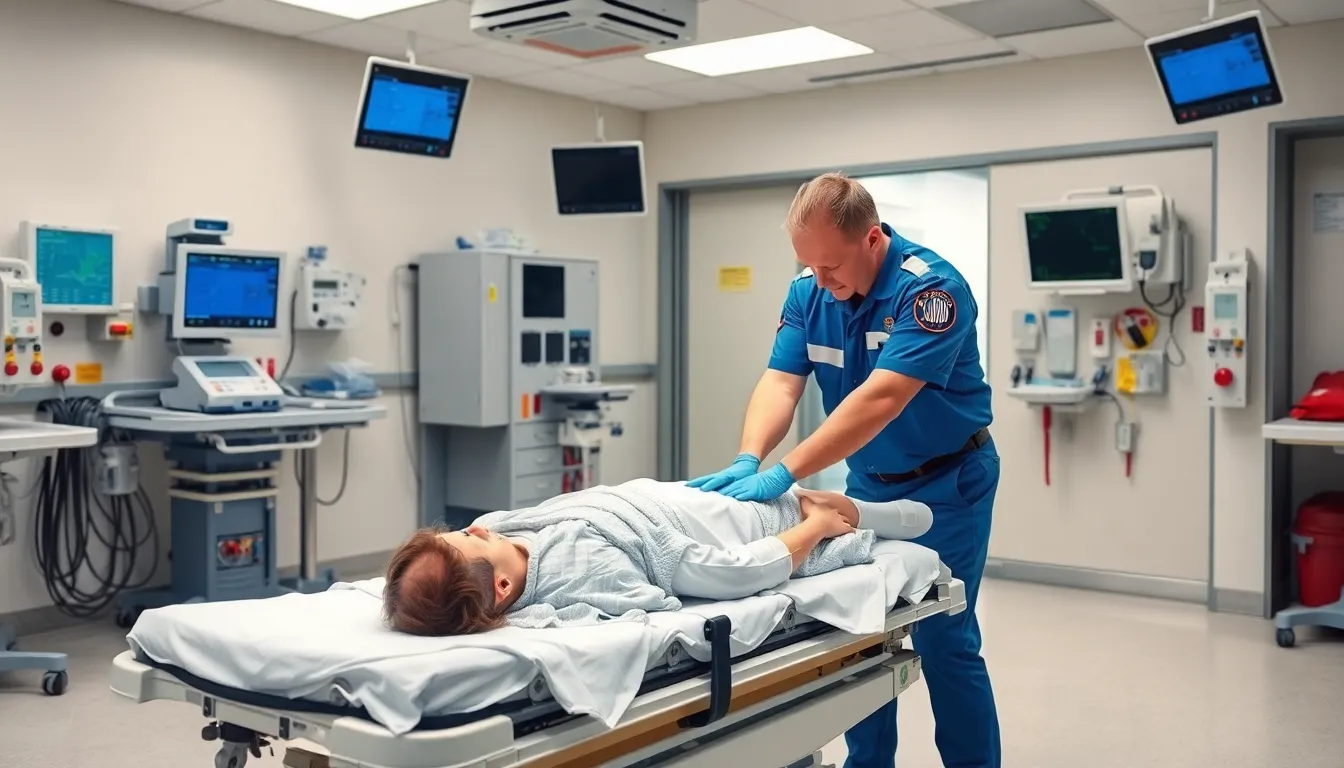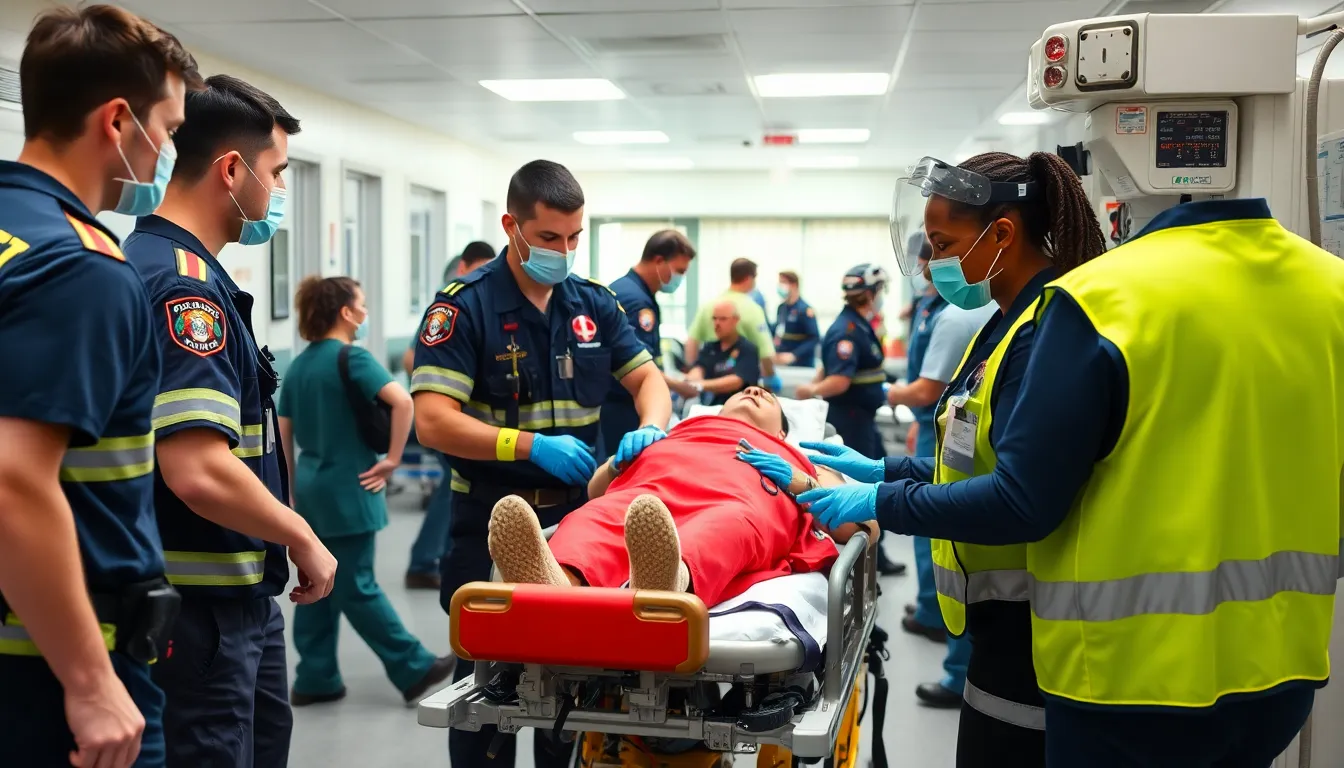In a world where life can throw curveballs faster than a speeding ambulance, understanding emergency patient care is crucial. It’s not just about knowing how to handle a paper cut or a stubbed toe. We’re talking about the high-stakes game of saving lives, where every second counts and a calm demeanor can turn chaos into order.
Table of Contents
ToggleOverview of Emergency Patient Care
Emergency patient care encompasses immediate medical responses to critical situations. Medical professionals must prioritize actions based on the severity of the condition presented. Understanding different types of emergencies is essential for effective intervention.
Critical incidents often include cardiac arrests, trauma cases, and severe allergic reactions. Providing rapid assessment and appropriate treatment can significantly impact patient outcomes. Techniques such as CPR and the use of automated external defibrillators are crucial in life-threatening scenarios.
Emergency medical services (EMS) play a vital role in transporting patients to hospitals. Quick transport minimizes delays in receiving advanced care. Personnel trained in advanced life support ensure that patients receive necessary interventions during transit.
Facilities offering emergency care employ specialized teams equipped to handle a wide range of medical issues. These teams evaluate and stabilize patients before further treatment. Timely diagnoses are crucial, enabling the initiation of life-saving procedures.
Protocols in emergency care often include triage systems for prioritizing patients. Triage helps direct resources to those in greatest need. Each patient’s situation dictates the urgency of care required, influencing treatment plans and hospital admissions.
Healthcare providers must also communicate effectively with patients and their families. Clear communication ensures that everyone involved understands the situation and treatment options. Empathetic interactions can alleviate anxiety in high-stress environments.
Continuous training and education for medical staff ensure preparedness for various emergencies. Teams participate in simulations and drills to maintain skills and improve responsiveness. This ongoing training enhances the overall capacity of emergency care systems to address unforeseen challenges.
Importance of Timely Intervention

Timely intervention in emergency patient care significantly influences the outcome of critical situations. Medically, quicker responses often improve survival rates in life-threatening cases.
Impact on Patient Outcomes
Rapid assessment and treatment directly enhance patient outcomes. For instance, studies show that immediate CPR can double or triple a cardiac arrest survivor’s chances. Timely intervention minimizes complications, reduces recovery time, and can prevent secondary injuries. Medical professionals can stabilize patients effectively when they act swiftly. Statistics indicate that response times below eight minutes in emergencies increase survival rates substantially. Overall, efficient emergency care leads to better prognoses, fostering hope for patients and their families.
Role of Emergency Services
Emergency services play a critical role in delivering timely patient care. Trained personnel, such as paramedics, provide essential care on-site before transport. Their expertise in life-saving techniques significantly impacts survival chances during transport. Research highlights that swift transportation to advanced care facilities drastically reduces mortality rates. Emergency services also utilize triage systems to prioritize cases based on severity, ensuring that those in critical need receive attention first. Coordination among healthcare teams enhances treatment processes, ultimately supporting better overall outcomes for patients facing emergencies.
Key Components of Emergency Patient Care
Emergency patient care encompasses critical aspects that enhance survival rates and recovery. Understanding these components ensures effective management of urgent medical situations.
Pre-Hospital Care
Pre-hospital care involves the immediate, onsite assessment and treatment of patients. Trained emergency medical personnel assess vital signs, provide essential treatments such as oxygen administration, and stabilize injuries. Rapid response times indicate a correlation with improved patient outcomes, drastically increasing survival rates, especially in cardiac arrest scenarios. Transporting patients to medical facilities occurs swiftly, minimizing delays in advanced care. Utilizing triage systems, first responders prioritize cases based on severity, ensuring that those in critical need receive prompt attention.
Emergency Room Procedures
Emergency room procedures focus on rapid evaluation and intervention. Medical staff conducts primary assessments upon patient arrival, identifying life-threatening conditions. Diagnostic imaging and lab tests often follow, giving accurate information for treatment decisions. Immediate interventions, such as medication administration and wound care, occur to stabilize patients. Coordination among medical teams becomes essential during this phase, improving treatment efficiency. Implementing established protocols significantly enhances the likelihood of positive outcomes, with studies showing that timely procedures reduce complications and hasten recovery.
Challenges in Emergency Patient Care
Emergency patient care faces several challenges that can complicate treatment and impact patient outcomes.
High Volume of Patients
High patient volumes often lead to overcrowding in emergency departments. Increased influx of patients can overwhelm medical staff, slowing response times. Higher numbers correlate with longer waiting times for individuals needing urgent care. Significant rises in patient traffic, especially during public health crises, stress resources. Staff may struggle to assess and treat each case effectively, which can hinder optimal care. Ensuring efficient triage processes becomes crucial to prioritize those with the most severe conditions. During peak times, effective communication among healthcare providers is essential to ensure all patients receive timely attention.
Resource Limitations
Resource limitations significantly impact the quality of emergency care. Inadequate supplies and insufficient manpower can stall critical interventions. Essential medical equipment, like ventilators and monitors, may fall short during emergencies. Limited access to specialized personnel also affects treatment capability, particularly for complex cases. Budget constraints often hinder the ability of emergency departments to maintain necessary staffing levels. Without proper resources, patient outcomes may decline due to delayed or inadequate care. Addressing these limitations requires strategic planning and resource allocation to enhance emergency response capabilities.
Innovations in Emergency Patient Care
Innovations are transforming emergency patient care, enhancing both effectiveness and efficiency.
Technology Integration
Telemedicine plays a crucial role in emergency patient care. This technology allows remote consultations, enabling physicians to assess patients quickly. Digital tools support real-time data sharing, integrating clinical information during emergencies. Drones deliver medical supplies to remote locations, significantly reducing transport times. Wearable devices monitor vital signs, ensuring timely interventions based on real-time data. Artificial intelligence assists in triaging patients, prioritizing cases based on severity. These advancements collectively streamline emergency response processes, ultimately saving lives.
Training and Protocols
Ongoing training ensures emergency personnel stay prepared for unexpected challenges. Simulation-based training improves skills and enhances response times in critical situations. Standardized protocols guide actions during emergencies, promoting consistency in treatment approaches. Regular drills familiarize staff with equipment and procedures, bolstering team coordination. Feedback mechanisms after training sessions identify areas for improvement, leading to better outcomes. Effective communication among team members enhances collaboration, ensuring seamless care delivery. Continuous education reinforces competency, aligning practices with the latest medical advancements.
Understanding emergency patient care is vital in saving lives during critical situations. The ability to respond quickly and effectively can significantly impact patient outcomes. By prioritizing rapid assessment and treatment, medical professionals can enhance survival rates and minimize complications.
Innovations in technology and continuous training for emergency personnel are transforming the landscape of emergency care. These advancements ensure that healthcare teams are well-equipped to handle unforeseen challenges while maintaining a high standard of care.
As the field evolves, staying informed about best practices and embracing new tools will be essential for improving emergency patient care and ensuring that every patient receives the timely intervention they need.



